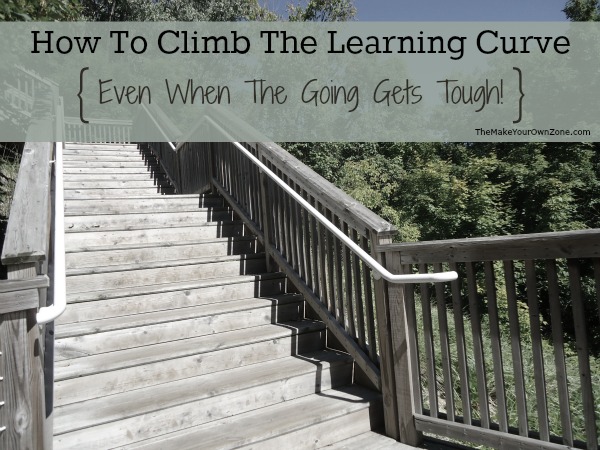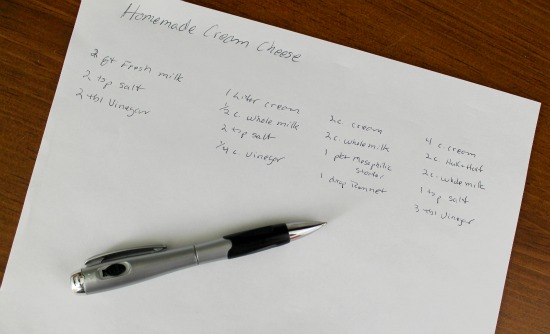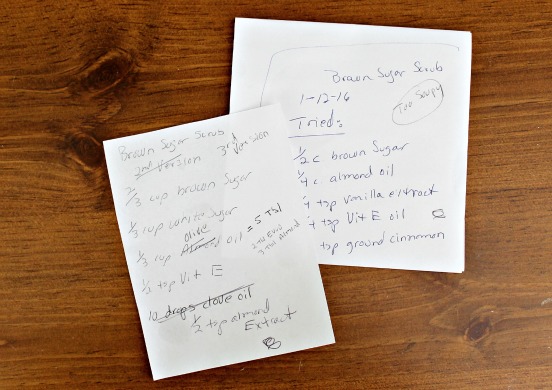How I Climb The DIY Learning Curve
I still remember a conversation I had with a sister-in-law several years ago. She was sharing with me her latest efforts in trying to get better at baking her own homemade bread. Homemade bread is something I haven’t mastered either and so I asked her, “Has it been hard baking your own bread?” Her answer was:
“Well, the actual baking of the bread isn’t hard, but the learning curve has been hard.”
And BOOM, there it is.
The initial trying and measuring and mixing and baking of a new recipe isn’t that hard to do. Most of us can handle that with no problem. BUT, when things don’t turn out exactly like we hoped, and the recipe flops, and the disappointment kicks in, that’s when we have to decide if we’re really going to battle forward and try to climb that learning curve.
My hope with this blog has been to give readers inspiration and recipes to try if they have come here looking for DIY ideas. I also know that getting started with new recipes and ideas isn’t something that is all smooth sailing. It’s often something that takes trial and error, and thinking and tweaking, until you are comfortable with what you are doing and have found a process that works best for you.
I have certainly experienced this too. In the five years I’ve been writing this blog I’ve tried a lot of new recipes. Some ultimately are good successes . . . and some are dismal failures. But if it’s something that I feel has good potential, then almost always, it will take me several times of making it before I’m finally comfortable with what I’m doing.
Yes, the learning curve usually doesn’t happen quickly or easily. It can be hard. But it can be rewarding too.
So today I thought I would share a few things I’ve learned about climbing the “Make Your Own” learning curve. Sometimes it’s hard to know if pressing forward with a new homemade idea or recipe is worth it, but the strategies below have made that process a little easier for me. If you are questioning getting started with a new homemade alternative, or have found yourself disappointed and discouraged in the midst of learning a new skill, perhaps you will find the points below helpful too.
Let’s take a look:
1 – Get Started: Compare Recipes Side-By-Side
One of the hardest things for me when getting ready to master a new recipe or learn a new skill is just finding the right information to get started!
The good thing about the internet is that it is full of information. The bad thing about the internet is . . . it is full of information. It is truly overwhelming sometimes. How do you even know which recipe to get started with? If you googled homemade bread you would probably find thousands of recipes!
One little trick I do in my beginning research is that after finding several recipes that look like good possibilities, is to write them down side by side on a sheet of paper, with the ingredients in the same order. This helps me see the big picture of how each of the recipes are utilizing the ingredients and in what ratios. There will always be some recipes that seem to be way out of whack with the others, using much more or less of an ingredient. This then helps me get off to a good start with my trial and error as I have already found the common thread (or the strange exceptions) in the many recipes to be found on the internet.
If you experience failure on the first try with a recipe, it’s not always clear what went wrong or what to change. This makes the learning curve difficult too. But having several recipes laid out side-by-side has often helped me see the common themes in the recipes, which in turn has helped me know what might need adjusting after a disappointing first try.
2 – Press On: Some Failure and Waste is OK
If you are a frugal sort of person, one of the hardest things about the learning curve will be what feels like the waste of ingredients. If something really turns out wrong, it can be soooo disappointing to just throw everything in the trash can. It can feel like such a waste of money. (Like my waste of chocolate on my failed chocolate covered cherries shown below) Nobody wants to waste chocolate!
BUT, sometimes you need to give yourself permission for some failure and waste because each effort is in fact teaching you something. If it’s a skill or recipe that you think still has some good potential for your family, then it wasn’t really a waste. It was a learning experience that taught you what NOT to do next time. And that’s why my second attempt at chocolate cherries was quite delicious.
I often remind myself that some failure and waste is going to happen, and that’s OK. I try to keep it within reason, of course, and I also make sure the failure and waste is leading to something I still feel has good potential.
If you are climbing up the learning curve, remember that failure and waste will usually show up as part of the process. It’s gonna happen. Give yourself some grace and keep moving forward.
3 – Still Going: Take Good Notes
When I keep trying after a failure, I’m always sure to make notes about what I do each time I try again. This has been very, very helpful to me. Perhaps some of you can trust your memories, but I usually can’t!
I recently shared a recipe for a Brown Sugar Body Scrub that I’m enjoying. That particular recipe took me three tries before I had something that felt right to me. As you can see in the snapshot above, I had notes that the first try was “too soupy”. I also wanted to scent my scrub and first tried ground cinnamon (didn’t do much), then tried clove oil (oops, too strong for skin!), and then finally hit on the one that I liked a lot – almond extract. I know I would not have remembered exactly what measurements I used and in which versions if I didn’t keep it all written down.
{And apparently my pens never work because my pages of notes always have scribbles where I am trying to make the pen work – Ha!}
So I would encourage anyone who’s climbing the learning curve to keep good notes on the way up. It will help you see what you’ve tried, what’s working, and what’s not.
4 – The Hardest Part: Trust Your Instincts
And finally, sometimes you just have to trust your instincts on that climb up the learning curve. Sometimes you can just “feel” if there’s promise in the recipe or if there’s not. Sometimes you have to know when to quit too.
There’s a fine line between perseverance for something with potential and stubbornness to make something work that doesn’t have potential. This can be a tough one for me. I hate to think I gave up too soon.
But if something is bringing me little or no enjoyment, is showing little payoff for all my hard efforts, and just doesn’t seem to be something of much value to my family, then I trust my gut and I tell myself it’s OK to quit.
That’s not to say I will never, ever try again on that particular experiment. Maybe I’ll come across some info farther down the road that sheds some light on my failures that inspires me to try again. I like to keep the door open on most ideas and experiments. However I’ve also learned that it’s OK to trust my gut feelings and direct my energy elsewhere where it can be better used when I’ve struggled too long on something with a small return for my efforts.
So don’t be afraid to climb the learning curve! It may not always be easy, but things of value often require more effort. Lessons learned often come because of previous failures. It’s all part of the process and I would encourage you to enjoy the journey on the way to your destination.







